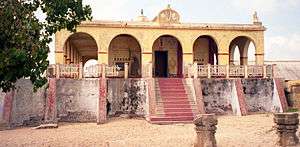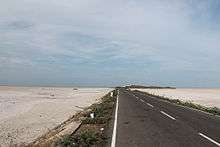Kothandaramaswamy Temple

The Kothandaramaswamy Temple at Rameswaram, Tamil Nadu is a shrine dedicated to the Hindu deity Rama. Located at a distance of 13 kilometres (8.1 mi) from Rameswaram, it forms the southernmost tip of the island.[1] The temple is the only historical structure to survive the 1964 cyclone that washed away Dhanushkodi. The temple has the deities of Rama, Lakshmana, Sita, Hanuman and Vibhishana. The temple is surrounded by sea and remains a tourist attraction. It is easily accessible from Rameswaram.
Historical background
The temple is estimated to have been constructed about 500-1000 years ago.[2] Rama, the main idol, is depicted as having a bow (Kothandam), and hence the name Kothandaramaswamy for the idol.[2]
The temple is believed to be the place where Vibhishana, the younger brother of Ravana, asked Rama and his vanara (ape men) army for refuge.[2] According to this tradition, after the abduction of Sita, Vibhishana advised Ravana to return her to Rama.[2] However, Ravana did not listen to the advice, which led to Vibhishana fleeing from Lanka and joining Rama's army. When Vibhishana surrendered to Rama, the vanara army urged Rama not to accept Vibhishana believing him to be a spy. However, Rama accepted Vibhishana under the insistence of Hanuman stating that it is his duty to protect the ones surrendered to him.[2] It is also said that after the slaying of Ravana, Rama performed the "Pattabhishekam" (ascension to king of Lanka) for Vibhishana at this place.[2][3] The story is depicted in painting across the walls inside the shrine.[4]
Location and importance

Situated on an island that is surrounded by Bay of Bengal and Gulf of Mannar,[2] the temple is located 13 kilometres (8.1 mi) from Rameswaram.[5] When Dhanushkodi was severely affected by the 1964 Rameswaram cyclone, the temple was the only structure that survived.[6][7][8] Swami Vivekananda is said to have visited the place after his historic trip to Chicago.
Sethusamudram project alignment
After Independence, six alignments were proposed for the implementation of the Sethusamudram Shipping Canal Project. Incidentally, the fourth of the six proposed alignments was dropped because it proposed that a large area around the Rameswaram island, including the temple, be demolished.[9]
References
| Wikimedia Commons has media related to Kothandaramaswamy Temple. |
- ↑ Dr. Shiv Sharma (2008). India - A Travel Guide. Diamond Pocket Books (P) Ltd. p. 730. ISBN 978-81-284-0067-4. Retrieved 5 June 2013.
- 1 2 3 4 5 6 7 "Kodandaramar Temple : Kodandaramar Temple Details | Kodandaramar- Rameswaram | Tamilnadu Temple | கோதண்டராமர்". Dina Malar. Retrieved 5 June 2013.
- ↑ Various (2003). Tourist Guide to South India. Sura Books. pp. 114–115. ISBN 978-81-7478-175-8. Retrieved 5 June 2013.
- ↑ Sunita Pant Bansal (1 January 2008). Hindu Pilgrimage. Pustak Mahal. ISBN 978-81-223-0997-3. Retrieved 6 June 2013.
- ↑ Jagir Singh Bajwa; Ravinder Kaur (1 January 2007). Tourism Management. APH Publishing. p. 292. ISBN 978-81-313-0047-3. Retrieved 5 June 2013.
- ↑ Ganapathy, Arun (15 September 2011). "A tale of two temples". The Times of India. Retrieved 7 June 2013.
- ↑ "City Development Plan - Rameswaram" (PDF). Directorate of Municipal Administration (DMA) - Government of Tamil Nadu. p. 81. Retrieved 7 June 2013.
- ↑ "Dhanushkodi". Ramanathapuram District website. Retrieved 7 June 2013.
- ↑ "Pachauri to head six-member experts committee". The Hindu. 31 July 2008. Retrieved 5 June 2013.
Coordinates: 9°14′00″N 79°20′53″E / 9.2333°N 79.3480°E